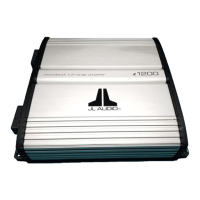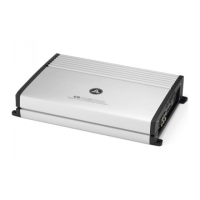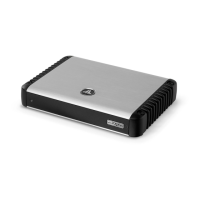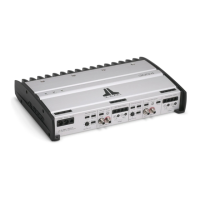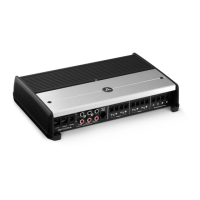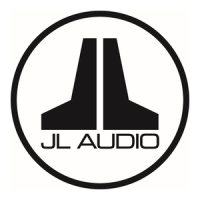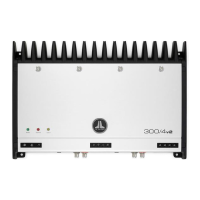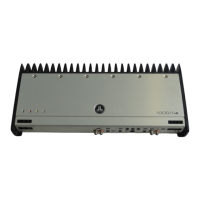10 | JL Audio - RD400/4 Owner’s Manual
BRIDGING CONSIDERATIONS
Bridging is the practice of combining the
output of two amplifier channels to drive a single
load. When bridged, each channel produces
signals of equal magnitude, but opposite polarity.
The combined output of the two channels
provides twice the output voltage available from
a single channel. The RD400/4 has been designed
for bridging of its main channel pairs without the
need for Y-adaptors or input inversion adaptors.
To bridge a pair of main channels, use the
“Left +” and “Right –”speaker connectors only
(the “Left –” and “Right +” remain unused). Each
bridged channel pair will deliver optimum power
into a 4 ohm load.
When a pair of the RD400/4’s channels are
bridged, they will deliver 200W x 1 into a 4 ohm
load or 150W x 1 into an 8 ohm load. Operating
a pair of bridged channels into a load lower than
4 ohms is not recommended and will cause the
amplifier to enter into protection mode.
Each channel pair of the RD400/4 is
equipped with an “Input Type” switch for
use when bridging. Setting the switch to
“Mono” will internally connect the left input
signal to both the left and right inputs of the
bridged channel pair, eliminating the need for
Y-adaptors.
When a pair of the RD400/4’s channels are
operating in bridged mode, the output will be in
mono (only one channel). This mono channel can
contain only right channel information, only left
channel information, or the sum of the signals
from right and left input channels. In order to
achieve one of these options, configure the inputs
to that pair of channels in one of these two ways:
1) Left Channel Only or Right Channel Only
Information: If you wish to send a left-only
or right-only signal to a pair of the RD400/4’s
channels, set the “Input Type” switch for
your bridged channel pair to the “Mono”
position. Doing so will internally connect a
mono signal to both left and right inputs of the
bridged channel pair. This option is used when
deploying a pair of the RD400/4’s channels to
drive left channel speakers only and the other
pair of the RD400/4’s channels to drive right
channel speakers only.
2) Left + Right Channel Information: When
bridged and fed by a stereo source signal,
set the “Input Type” switch for your bridged
channel pair to the “Stereo” position. A
bridged pair of the RD400/4’s channels will
automatically combine the left and right input
signals into a summed mono (left + right) input
signal. This option is useful when using a pair
of the RD400/4’s channels to drive a subwoofer
system or a summed mono center channel.
STATUS LED / PROTECTION CIRCUITRY
There is a bi-color LED light strip on the top
surface of the amplifier to indicate the amplifier’s
operating status. Note: When the amplifier is
powering up, the outputs are muted and the light
strip will turn red for a 3 seconds.
Clipping
Clipping
1) Constant Blue: The amplifier is on and
functioning normally, audio output is active.
2) Constant Red: lights to indicate that the
amplifier has exceeded its safe operating
temperature, putting the amplifier into a
self-protection mode, which mutes the power
output of the amplifier. When its temperature
returns to a safe level, the red light will return
to blue and the amplifier will return to normal
operating mode.
3) Momentary Red: The light strip will turn
red for a ½ second and mute the amplifier’s
output during an over-current condition. It
will then attempt to restart (with a blue light).
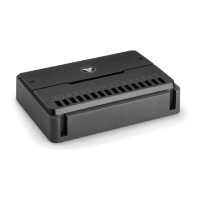
